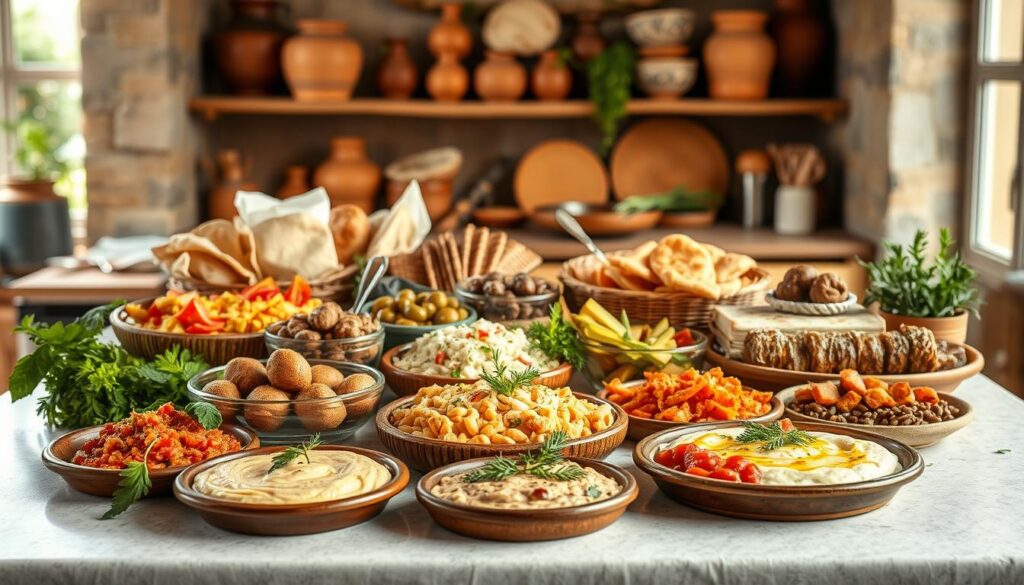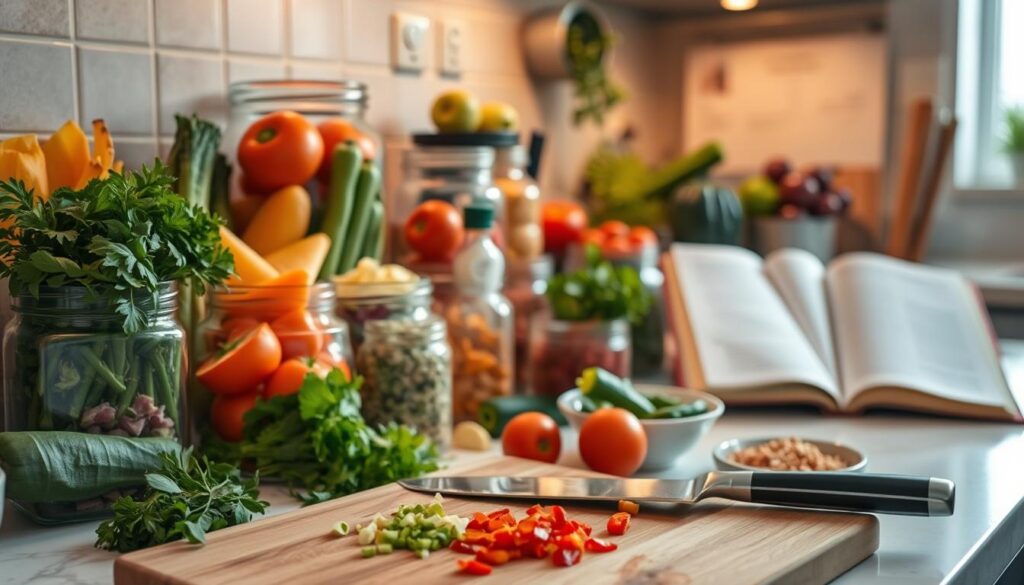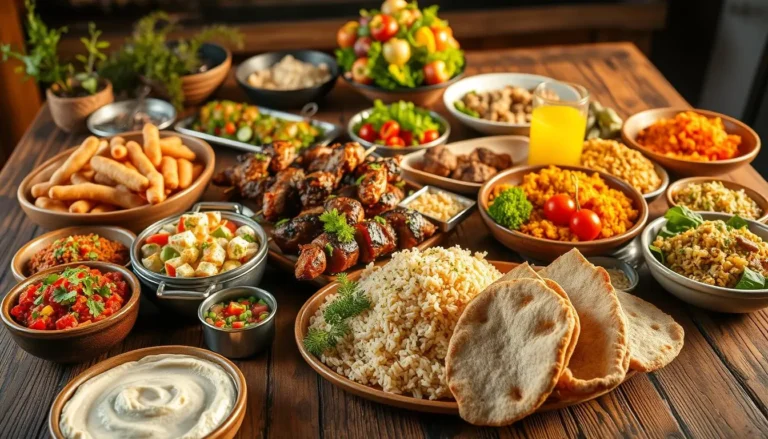Explore the rich flavors of Lebanese cuisine, a key part of Middle Eastern dishes. Learn to make delicious Lebanese food easily with simple steps and ingredients.
Authentic recipes are the secret to making memorable Middle Eastern dishes. With the right ingredients and cooking methods, you can impress your friends and family.
Mastering easy Lebanese recipes lets you make a variety of authentic dishes. You’ll learn to prepare Lebanese cuisine like a pro, from traditional favorites to modern twists.
Introduction to Lebanese Cooking
In this guide, you’ll learn the basics of Lebanese cooking. You’ll discover essential pantry ingredients, must-have kitchen tools, and easy recipes. Whether you’re new to cooking or experienced, making authentic Lebanese recipes is easier than you think.
Key Takeaways
- Learn the basics of Lebanese cuisine and Middle Eastern dishes
- Discover authentic recipes and cooking techniques
- Explore the essential pantry ingredients for Lebanese cooking
- Find out which kitchen tools you need to prepare Lebanese cuisine
- Get started with easy Lebanese recipes and cooking methods
- Master the art of preparing delicious Middle Eastern dishes
Table of Contents
Understanding the Essence of Lebanese Cuisine : Easy Lebanese Recipes
Exploring Lebanese cooking reveals a rich tapestry of history, geography, and culture. The Mediterranean diet greatly influences its flavors, focusing on healthy eating and natural ingredients. This approach helps in making tasty, nutritious meals for any event.
At the core of Lebanese cuisine is a focus on fresh ingredients, whole grains, and aromatic spices. To make authentic dishes, it’s crucial to balance these elements. This balance highlights the unique tastes of each ingredient. Whether cooking for one or many, following the Mediterranean diet guides you in choosing the right ingredients and cooking methods.
Some essential ingredients in Lebanese cuisine include:
- Olive oil, which adds a rich and fruity flavor to dishes
- Garlic, which provides a pungent and aromatic flavor
- Lemon juice, which adds a bright and tangy flavor
- Cumin, coriander, and sumac, which add depth and warmth to dishes
By embracing the Mediterranean diet and healthy eating, you can craft delicious, nutritious Lebanese dishes. Whether you’re an experienced cook or new to the scene, Lebanese cuisine offers something for everyone. Its rich flavors, aromas, and focus on natural ingredients make it a standout in your kitchen.
Essential Lebanese Pantry Ingredients
To cook tasty Lebanese dishes, you need some key pantry staples. These include olive oil, garlic, lemon juice, and Lebanese spices like cumin, coriander, and sumac. Having these ingredients ready will help you make a delicious Lebanese meal.
Other important pantry staples are bulgur, rice, and chickpeas. Bulgur is great for tabbouleh, a salad with parsley, tomatoes, and mint. Rice is used in many dishes, like stuffed grape leaves and chicken machboos. Chickpeas are essential for hummus, a favorite Lebanese dip.
- Olive oil
- Garlic
- Lemon juice
- Cumin
- Coriander
- Sumac
- Bulgur
- Rice
- Chickpeas
With these pantry staples and Lebanese spices, you’re ready to make delicious Lebanese dishes. Always choose fresh and high-quality ingredients for the best taste and texture.
Must-Have Kitchen Tools for Lebanese Cooking
Having the right kitchen tools is key for cooking Lebanese dishes. Basic tools can work, but traditional and modern tools can improve your cooking. Tools like a mortar and pestle, clay oven, and shawarma grill are great for making hummus, tabbouleh, and shawarma.
Today, you can also use a food processor, slow cooker, and grill pan. These tools make cooking Lebanese dishes easier and more convenient. For instance, a food processor is perfect for making dips like hummus and baba ganoush. A slow cooker is great for cooking stews and braises, such as lamb shanks and chicken machboos.
Essential Kitchen Tools
- Mortar and pestle for grinding spices and making dips
- Food processor for making hummus, baba ganoush, and other dips
- Slow cooker for cooking stews and braises
- Grill pan for making shawarma and other grilled meats
Tools like a falafel maker or kunafeh cutter can also be helpful. With these tools, you can dive into Lebanese cuisine and make tasty meals with ease.
Easy Lebanese Recipes for Beginners
Starting your journey into Lebanese cuisine is exciting. You’ll find many easy recipes perfect for beginners. These beginner-friendly dishes introduce you to Lebanese flavors and techniques gently. You can try classic dips like hummus and fresh salads like tabbouleh.
Popular easy recipes for beginners include shawarma, falafel, and stuffed grape leaves. These dishes are tasty and simple to make. With basic ingredients and simple techniques, you can make authentic Lebanese dishes that will wow your guests.

For a great Lebanese cooking experience, stock up on essentials like olive oil, lemon juice, and sumac. You can find these at Middle Eastern grocery stores or online. With these ingredients, you can make a variety of easy recipes and enjoy Lebanese flavors at home.
Here are some tips for cooking Lebanese dishes:
- Use fresh ingredients whenever possible
- Don’t be afraid to experiment with new spices and flavors
- Keep it simple – many easy recipes are designed to be quick and easy to prepare
Mastering Lebanese Mezze
Mezze is a key part of Lebanese cuisine, offering a variety of small dishes. These dishes can make your cooking better. They are perfect for sharing and enjoying with others, great for social gatherings.
Exploring Lebanese mezze, you’ll find many flavors and textures. From classic dips like hummus to refreshing salads, each dish is unique. To make authentic mezze, balance and harmony in your dishes are crucial.
- Hummus: a creamy dip made from chickpeas, tahini, and lemon juice
- Baba ganoush: a smoky eggplant dip with a rich, velvety texture
- Tabbouleh: a fresh salad featuring parsley, tomatoes, and bulgur
These dishes are not only tasty but also good for you. Mastering Lebanese mezze lets you create stunning appetizers and dips. They will impress your friends and family.
Lebanese Main Course Dishes
Lebanese dishes offer a wide range of main courses to satisfy your appetite. From hearty stews to flavorful kebabs, there’s something for everyone.
Some popular Lebanese food main courses include:
- Shawarma: a classic street food made with meat and served in a pita bread with vegetables and tahini sauce.
- Kebabs: skewers of marinated meat and vegetables, grilled to perfection.
- Stews: hearty, slow-cooked dishes made with meat and vegetables, often served with rice or bread.
These Lebanese dishes are not only delicious but also made with fresh ingredients. They are a great option for a healthy and satisfying meal. Whether you’re in the mood for something classic or new, Lebanese main courses will satisfy your cravings.
Traditional Lebanese Bread Making
Exploring Lebanese cuisine, you’ll find bread making is key. You’ll learn to make tasty breads that go well with meals. From pita bread to man’oushe, each bread has its own special qualities.
To start making Lebanese bread, you need to know the basics. This includes using the right flour, yeast, and water. Here are some important tips:
- Choose high-quality flour for a strong dough.
- Let the dough rise for at least an hour for a light texture.
- Preheat your oven correctly for a crispy crust and soft inside.
After mastering the basics, you can try making pita bread or man’oushe. With practice, you’ll make many delicious Lebanese breads. They’ll make your meals better and impress your guests.
| Bread Type | Ingredients | Instructions |
|---|---|---|
| Pita Bread | Flour, yeast, water, salt | Mix dough, let rise, bake at 450°F |
| Man’oushe | Flour, yeast, water, salt, toppings | Mix dough, let rise, top with ingredients, bake at 400°F |
Easy Lebanese Recipes : Lebanese Desserts
Explore the sweet world of Lebanese desserts. Here, traditional pastries meet modern twists for a delightful experience. You’ll find everything from classic baklava to new sweet treats, all easy to make and full of flavor. Lebanese pastries are known for their rich tastes and textures, often including nuts, honey, and rose water.
Popular desserts like ma’amoul, a shortbread-like cookie filled with dates or nuts, and kunafeh, a creamy dessert with shredded phyllo dough and cheese, are favorites. Ghuriba, a semolina cake soaked in syrup, is also loved by many. These desserts are not only tasty but also beautiful, making them great for any occasion.

Start making these sweet treats at home with simple recipes. You can then try new flavors and ingredients. Many Lebanese desserts are easy to make, needing just a few ingredients and basic cooking skills. With practice, you’ll impress your friends and family with stunning desserts.
For making Lebanese desserts, use top-quality ingredients like fresh nuts and real rose water. Also, focus on texture and presentation. Try different flavors, like orange blossom water or cardamom, to make unique desserts. With creativity and practice, you can master Lebanese desserts and enjoy them all year.
Common Mistakes to Avoid in Lebanese Cooking
Exploring Lebanese cuisine means knowing common mistakes that can ruin flavor and authenticity. Seasoning balance is key, as too much or too little can change the taste. Also, ingredient substitutions can be tricky, especially with unique Lebanese spices and ingredients.
Understanding cooking techniques is crucial. Lebanese cooking emphasizes the right oil and methods. Avoiding these mistakes ensures your dishes are tasty and true to Lebanese tradition. Some common errors include:
- Over- or under-seasoning with salt, pepper, or other spices
- Using incorrect ingredient substitutions, such as replacing sumac with paprika
- Not cooking ingredients for the right amount of time, resulting in undercooked or overcooked dishes
Avoiding these cooking mistakes and focusing on seasoning balance and ingredient substitutions will improve your Lebanese cooking. Use fresh, quality ingredients and don’t hesitate to try new recipes.
With practice and patience, you’ll master authentic Lebanese dishes. You’ll learn to avoid mistakes that can harm flavor and quality. By perfecting Lebanese cooking, you’ll impress everyone with your delicious dishes.
Time-Saving Tips for Lebanese Meal Prep
Meal prep can change the game in Lebanese cooking. By using time-saving tips, you can make delicious Lebanese dishes quickly. Start by preparing ingredients ahead of time. This includes chopping veggies, marinating meats, and cooking grains like rice and bulgur.
Cooking in bulk is another smart move. Lebanese dishes often make large amounts of food. You can refrigerate or freeze these for later. For example, make a big batch of lentil soup or stew. Freeze it for up to three months. Then, just thaw and reheat when you’re ready.
Turning leftovers into new dishes is also a great way to save time. In Lebanese cooking, leftovers can become new meals. For example, leftover roasted chicken can be made into chicken shawarma or chicken fatteh. This method reduces waste and adds variety to your meals.

- Plan your meals in advance to ensure you have all the necessary ingredients
- Use a slow cooker to prepare dishes like stews and soups while you’re busy with other tasks
- Keep a well-stocked pantry with essential Lebanese ingredients like olive oil, lemon juice, and spices
By using these tips, you can enjoy Lebanese cooking’s rich flavors and health benefits. You’ll save time and effort in the kitchen too.
Conclusion: Bringing Lebanese Flavors Into Your Kitchen
Lebanese cuisine is full of exciting flavors, textures, and health benefits. You can easily add these to your cooking at home. By learning about pantry items, cooking techniques, and recipes, you can bring Lebanon’s essence into your kitchen.
Lebanese cooking is all about trying new things and adding your own twist to classic dishes. Don’t hesitate to try new recipes and adjust flavors to your liking. Soon, you’ll be making delicious hummus, tabbouleh, and main dishes that will wow everyone.
Start your tasty journey through Lebanese cuisine. Let the Lebanese flavors brighten up your kitchen with the lively, healthy, and satisfying tastes of the Middle East. Bon appétit!
FAQ
What are the key flavor profiles in Easy Lebanese Recipes ?
Lebanese cuisine is known for its rich flavors. Cumin, coriander, and sumac are key. They add warmth and depth to every dish.
What are some essential Lebanese pantry ingredients?
Must-haves in a Lebanese pantry include olive oil and garlic. Don’t forget lemon juice and spices like cumin, coriander, and sumac. Bulgur, rice, and chickpeas are also staples.
What are some traditional Lebanese kitchen tools?
Traditional tools include a mortar and pestle, a clay oven, and a shawarma grill. But, you can also use a food processor, slow cooker, or grill pan for modern convenience.
How can I make hummus from scratch?
Making hummus is simple. Just blend chickpeas, tahini, lemon juice, garlic, and olive oil until it’s smooth and creamy.
What are some common mistakes to avoid in Lebanese cooking?
Avoid substituting ingredients incorrectly and using the wrong cooking methods. Also, make sure to season dishes just right.
How can I save time when cooking Lebanese dishes?
To save time, prepare ingredients ahead of time. Cook in bulk and use leftovers to create new dishes.
There are no reviews yet. Be the first one to write one.

